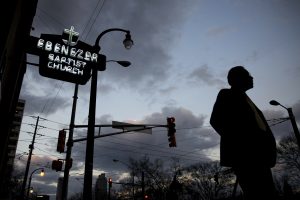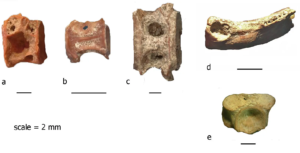Noli Rictor has won the $100,000 top prize at the National Aboriginal and Torres Strait Islander Art Awards (NATSIAAs), the longest-running and most prestigious award for Indigenous artists.
Rictor, a Pitjantjatjara elder, won the Telstra Art Award for his painting of Kamanti in the north of the Spinifex Lands. It’s the home of Wati Kutjara Tjukurpa (Two Men Creation Line), the story of a father and son water serpent making a journey through Country creating sacred sites along their way.
Very few details of the story are public, but Rictor came to know it because he travelled through the Country as a young man and drank from a waterhole at one of the sacred sites as a tjitji (child).
The judges for the prize, Kamilaroi curator Keith Munro, Kullilli/Yuggera curator Katina Davidson, and Wangkajunga cultural adviser Putuparri Tom Lawford, highlighted the work’s scale, at 2.9 metres x 2 metres. They also complimented its composition as “an expression of the artist’s command of painting and a visual representation of the artist’s vast knowledge of Spinifex Country and Law”.
“His expert use of colour and composition creates shimmering fields … At times the paint dances on the canvas’ surface; disrupting the eyes’ ability to focus, giving the work a truly mesmerising appeal from its painterly merits.”
Rictor told ABC RN’s Awaye!, through Riley Adams Brown, studio manager of his arts centre, Spinifex Arts Project: “Winning’s made me really happy, really proud, and the money coming has made me even happier.”
The artist is one of seven winners at the NATSIAAs this year, including $15,000 awards for general painting, work on paper, bark painting and more.
The change painting can bring
Having driven 25 hours from his home in Tjuntjuntjara to Alice Springs to catch a flight to Darwin for the NATSIAAs, Rictor plans to use his prize money to buy a new car.
“Cars are really important to be able to go to funerals and cultural business and also go hunting, because I’m the number one hunter in Tjuntjuntjara, and love supplying my family with an ample supply of malu [red kangaroo],” he says.
Born in 1969, Rictor grew up with his immediate family in the Great Victoria Desert in Western Australia – within kilometres of Maralinga, where the British tested nuclear weapons between 1952 and 1963.
In 1984, Australian authorities realised the extent of the contamination of the area. Two years later, Rictor, aged 21, and his family were found by relatives, who convinced them to move to Yakadunya, a settlement further away from the testing sites.
Rictor first started painting in 2004 at Kalka in the far northwest of South Australia, but stopped after creating his first few works. He started again in 2016, and now works with the Spinifex Arts Project.
He was initially inspired to make art after seeing other artists from the Spinifex Lands — including his older brother Ian Rictor — using painting to demonstrate their right to native title.
“They used to paint their birth sites to show no one has the right to take that Country away from them,” says Rictor.
“I saw all those Old People painting and saw how much change it can bring.”
Being raised on Country has also shaped Rictor’s approach to art-making.
“I paint very, very large scale. I’ve got lots of patience to sit down and paint for two, three, four days straight. Maybe young people struggle a little bit with the attention nowadays, but I’m really focused on my practice,” he says.
Acknowledging emerging artists
Josina Pumani, a Pitjantjatjara artist born in Mimili, in the Anangu Pitjantjatjara Yankunytjatjara (APY) Lands, won the emerging artist award for Maralinga, a clay pot that tells the story of nuclear testing in South Australia.
Its bulbous top elicits the cloud and winds of the nuclear explosion, with its black exterior colour representing the cloud and fallout, while the red colour inside indicates the immense heat of the blast.
Making the work was Pumani’s first time working with ceramics, having been a painter since 2009.
“It came from my heart,” she says.
“Black smoke came to our Country and infected all my family.
“I’m keeping my story alive. Now I’m making pots so everyone can see, and all my sons, nephew and niece can pass [the story] on.”
The judges described how Pumani’s work recentres the voices of Indigenous peoples impacted by Maralinga – at a time when the use of nuclear power is again up for debate.
“Here, the story of Aboriginal people being left behind and exposed to the fallout is shared through new eyes,” the judges said.
Natalie Davey – an artist of Bunuba, Walmajarri, Scottish and English heritage — also used her work to draw attention to an issue facing her community.
She won the multimedia award for River report: a hand-painted storyboard and 10-minute, first-person documentary video that showed flooding at her home in Fitzroy Crossing in Western Australia in 2023.
It was WA’s worst flooding event in recorded history: more than 1,500 people were evacuated and 240 properties were damaged, with Davey losing her home.
Throughout the flood, Davey communicated with other residents over social media.
“Everything changed so quickly, so I had to keep updating people,” she says.
But Davey didn’t set out to turn her recordings into an artwork.
“It just started off as me looking back on them to process what had happened … It was a way of healing,” she says.
“I really wanted to be able to continue sharing that story, because there’s so many people in Australia that are going through climate change events.
“We need to get it out there so we can start working on: how do we look after Country so it looks after us?”
The judges praised Davey’s innovation and “how the artist turned this devastating event into inspiration for her artistic practice”.
Pumani and Davey are amongst the 21 NATSIAA finalists who are emerging artists, out of 72 finalists in total.
Davey is thrilled to be a part of a new generation of Indigenous artists.
“It just fills me with so much joy that there’s all these other artists finding their voice, finding their medium for storytelling, and finding their connection and strength,” she says.
Judge and curator Katina Davidson says it was a joy to encounter some of these artists for the very first time.
“It’s really exciting when the quality of work is so exceptional: It just really energises us as judges, but also people who work in the industry, to know that our industry is alive and it’s thriving and it’s excelling into the next generation.”
The NATSIAA exhibition runs until January 27 at Museum and Art Gallery Northern Territory, Darwin.




